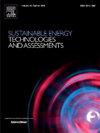Renewables usage maximization in automated distribution networks by coordinated operation of dynamic line rating and dynamic network reconfiguration
IF 7.1
2区 工程技术
Q1 ENERGY & FUELS
Sustainable Energy Technologies and Assessments
Pub Date : 2024-11-06
DOI:10.1016/j.seta.2024.104069
引用次数: 0
Abstract
Incorporation of smart-grid technologies (SGTs) in today’s electric distribution networks (DNs) has enabled distribution network operators (DNOs) to have an on-line supervision over the network equipment for optimal operation. This paper proposes a new approach for optimal scheduling of active DNs aiming at minimizing the curtailment power of wind and photovoltaic (PV) units as renewable energy sources (RESs). This purpose is fulfilled by minimizing the imported power from the transmission network resulting in maximization of renewables usage and minimization of power loss. The conducted approach is based on dynamic line rating (DLR) and dynamic network reconfiguration (DNR) as flexibility options. A convex formulation is employed to incorporate the objective function and constraints into a mixed-integer quadratically-constrained programming (MIQCP) model which is solved by global optimum solvers in GAMS. The proposed model is applied to the IEEE 33-bus system under different case studies, and the simulation results are analyzed. The obtained results indicate that the maximum scheduling of wind and PV units’ is fulfilled with the minimum energy losses. By the aid of DNR and DLR in a coordinated manner, the renewables scheduling is increased by about 64% while the energy loss is reduced by 29% compared to the base case.

通过协调运行动态线路额定值和动态网络重新配置,实现自动化配电网络中可再生能源使用的最大化
智能电网技术(SGT)在当今配电网(DN)中的应用使配电网运营商(DNO)能够对配电网设备进行在线监控,以实现最佳运行。本文提出了一种新的有功配电网优化调度方法,旨在最大限度地减少风能和光伏(PV)装置作为可再生能源(RES)的削减功率。为实现这一目的,可最大限度地减少从输电网络输入的电力,从而最大限度地利用可再生能源并减少电力损耗。所采用的方法以动态线路额定值(DLR)和动态网络重新配置(DNR)作为灵活性选项。采用凸公式将目标函数和约束条件纳入混合整数二次约束编程(MIQCP)模型,并通过 GAMS 中的全局最优求解器进行求解。将提出的模型应用于不同案例研究下的 IEEE 33 总线系统,并对仿真结果进行了分析。仿真结果表明,风电和光伏发电单元的最大调度得到了满足,能量损失最小。在 DNR 和 DLR 的协调辅助下,与基本情况相比,可再生能源调度增加了约 64%,而能量损失减少了 29%。
本文章由计算机程序翻译,如有差异,请以英文原文为准。
求助全文
约1分钟内获得全文
求助全文
来源期刊

Sustainable Energy Technologies and Assessments
Energy-Renewable Energy, Sustainability and the Environment
CiteScore
12.70
自引率
12.50%
发文量
1091
期刊介绍:
Encouraging a transition to a sustainable energy future is imperative for our world. Technologies that enable this shift in various sectors like transportation, heating, and power systems are of utmost importance. Sustainable Energy Technologies and Assessments welcomes papers focusing on a range of aspects and levels of technological advancements in energy generation and utilization. The aim is to reduce the negative environmental impact associated with energy production and consumption, spanning from laboratory experiments to real-world applications in the commercial sector.
 求助内容:
求助内容: 应助结果提醒方式:
应助结果提醒方式:


